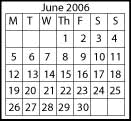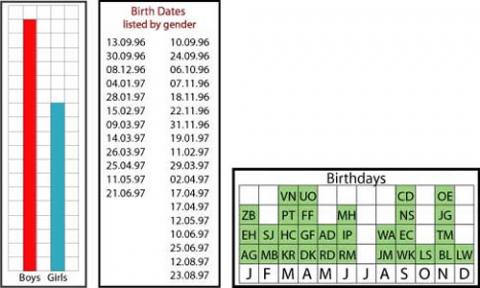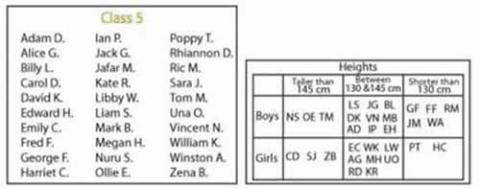Presenting the project
Have a look at all the information Class 5 have collected about
themselves. Can you find out whose birthday it is today?
Problem
There are thirty children in Class 5. All the first part of the summer term they had been doing a project collecting data about themselves and making all sorts of lists, charts and graphs to present it.
Now it is June and they are going to present all they have done in the project to the whole school. There is double excitement in the classroom that day because it is also one of the children's birthdays.
Image

Here is some of the work they have done:
Image

On what day did Class 5 present their work?
Here are some more charts and posters made by Class 5 for their project. The pie chart shows the children's hair colour.
Image

Image

What information can you find out about the child whose birthday it was on project day?
There are twins in this class. What information can you find out about them?
Getting Started
What days of the week will the presentation day not be on?
It might be helpful to make lists of all the information you can. For example, is the pupil a boy or a girl?
Perhaps you can find out his or her initials and then the name?
What colour hair does she or he have?
Student Solutions
We had some very clear solutions from pupils at Tunbury Primary School and Burlish Middle School. Thank you! Hannah, Alice, Katy, Caitlin, James, Morgan and Jonat from Tunbury said:
We discovered that the class presented their project on Wednesday 21st June. We found this out by looking at the birthday, birth date and calendar charts. We found 3 birthdays in June on the 10th, 21st and 25th. It couldn't be the 10th or the 25th as the calendar shows these are on Saturday and Sunday.Then we looked at the birth dates chart and saw that there were 18 dates on one side and 12 on the other side. We looked at the first chart, there were 12 girls and 18 boys so the person was a girl. The only girl's name with initials that matched the 3rd chart was Megan H. She was born in 1997 and was 8 years old when we did the investigation. Her height is between 130 and 145 cm and she is the youngest girl in her class.
The two twins are George Fand Fred F. We found this out by looking at the birthday dates and seeing who had the same birthdays. Their birthday is April 17th 1997. Then we looked at at the other birthday chart and looked on the 4th month and looked to who had the same 2nd name. After that we looked at the name chart and saw that the initials were F.F. and G.F. so they are Fred and George. The boys are 9 years old and are smaller than 130cm.
Laura, Molly and Amy from Burlish found out a little more information about the twins. They wrote:
To find the twins we looked on the Birthday list and spotted in the boys' column that two children had a birthday on the 17th April. We then looked at the date chart for April and saw that two children shared the same last initial. This told us that the twins were George F and Fred F. They have brown hair (we interpreted the colours this way because black, brown and blonde are the most common hair colours, although some people in our class thought it could be blonde, red and black). They are both shorter than 130cm which is lower than the average height for their class. They were 9 years old.Teachers' Resources
Why do this problem?
This problem requires learners to use the different forms of data to answer questions. It is made harder by the fact that they will need to look at more than one chart/table/graph in order to answer a single question.
Possible approach
The individual charts are not too difficult to interpret and so a good way into this activity might be to ask some introductory questions about a few of them in turn, just concentrating on one at a time.
At a basic level, this might involve just checking that the class know what M, T, W etc stand for in the calendar and similarly what J, F, M etc mean. You might also want to ask whether there are more boys or more girls in this class. These initial questions will enable the group to become more familiar with the data without the problem itself becoming trivial.
After this introduction learners could work in pairs on the problem on a computer or from a printed sheet so that they are able to talk through their ideas with a partner.
You may find it useful to have larger copies of the charts to project or have on the board. Here are pdfs each containing an enlarged image:
Key questions
Which graphs do you think you need to look at to answer that question?
What do you think M, T, W etc/ J, F, M etc/ ZB, EH, AG etc stand for?
What days of the week will the presentation day not be on?
How many birthdays are there in June? What days of the week are they on?
Can you find out any children who have the same birthdays?
